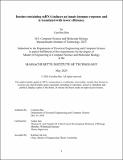Inosine-containing mRNA induces an innate immune response and is translated with lower efficiency
Author(s)
Bao, Caroline
DownloadThesis PDF (13.10Mb)
Advisor
Jain, Ankur
Terms of use
Metadata
Show full item recordAbstract
Inosine is a nucleoside formed by deamination of adenosine by adenosine deaminases acting on RNA (ADAR). ADAR editing activity is known to play a key role in modulating the host cell’s immune response to RNA. Here, we specifically study the effect of the presence of inosine in RNA by generating an inosine-containing reporter mRNA sequence. We also generated mRNA sequences that contained pseudouridine, an RNA modification known to decrease immune response to in vitro transcribed (IVT) mRNA and elevate the expression of the encoded gene, to examine the interaction between pseudouridine and inosine modifications.
While A-to-I editing activity is required for endogenous RNA to evade the innate immune response, our results show that inosine-containing IVT RNA induces an elevated immune response and is translated at a lower efficiency. This effect is dominant over pseudouridine modification, such that mRNAs containing both pseudouridine and inosine modifications still potently activate the innate immune response and exhibit a loss of translation. These results point to the potent immunostimulatory effects of inosine in transfected IVT mRNA. This elevated immune response is likely receptor-specific and we have demonstrated that it cannot be attributed to the sensors RIG-I, MDA5, TLR3, or PKR.
Date issued
2024-05Department
Massachusetts Institute of Technology. Department of Electrical Engineering and Computer SciencePublisher
Massachusetts Institute of Technology